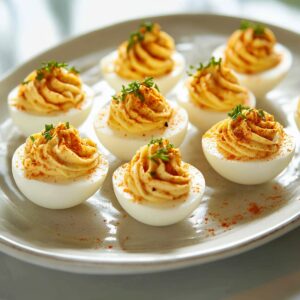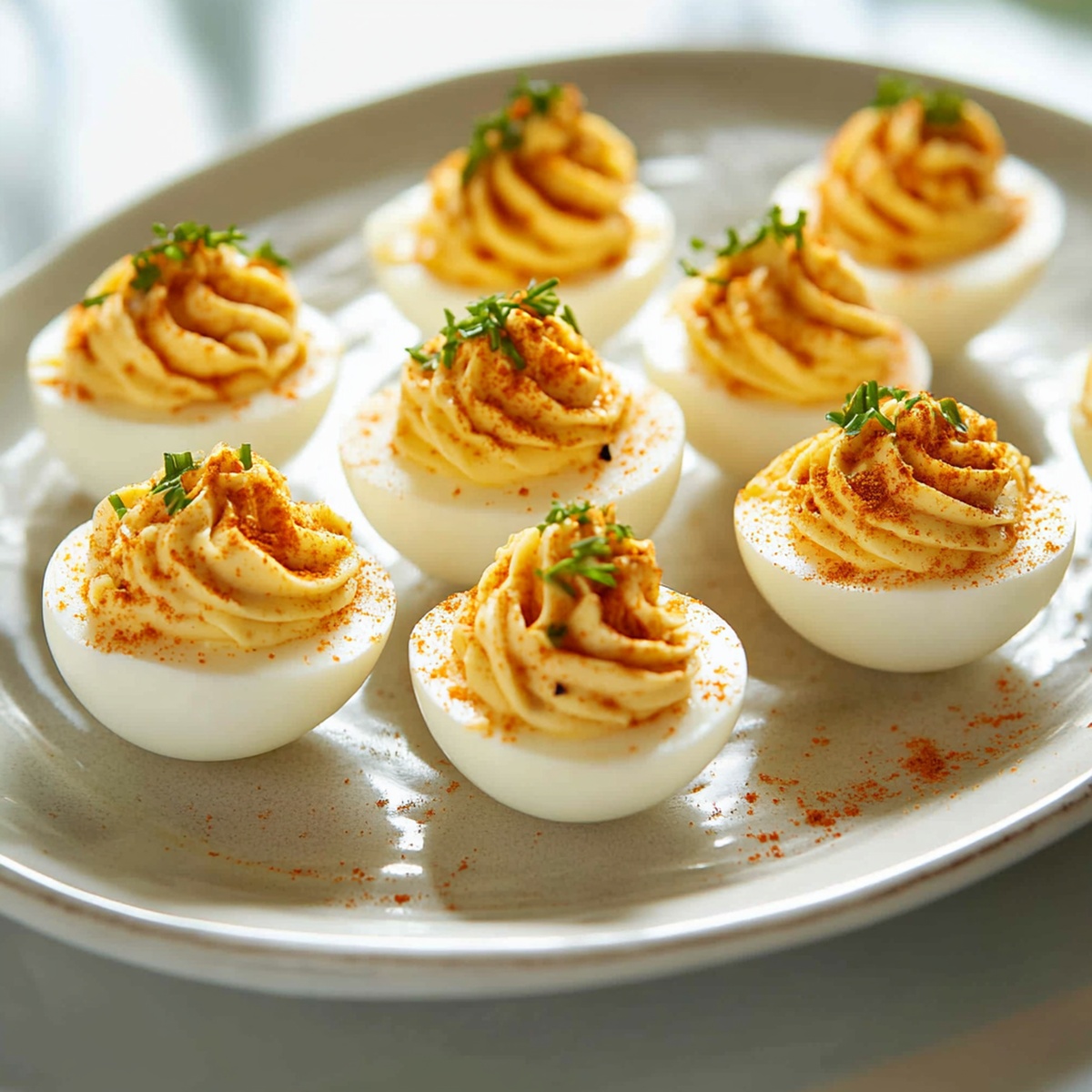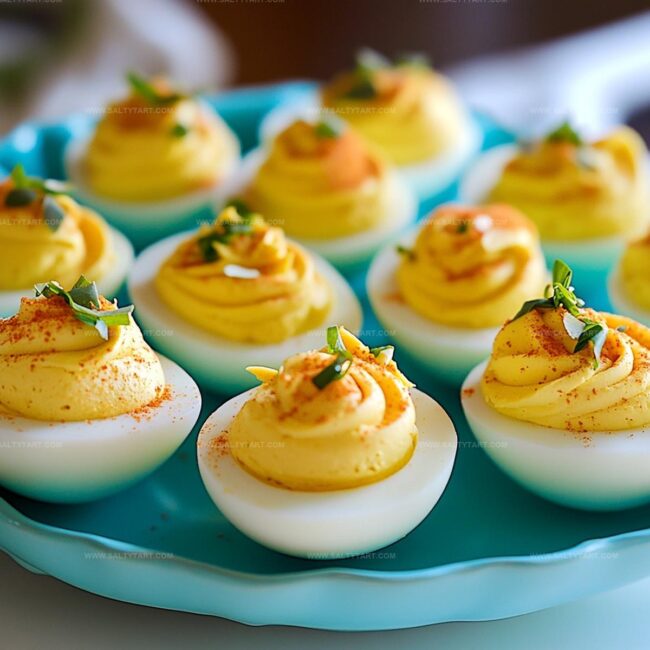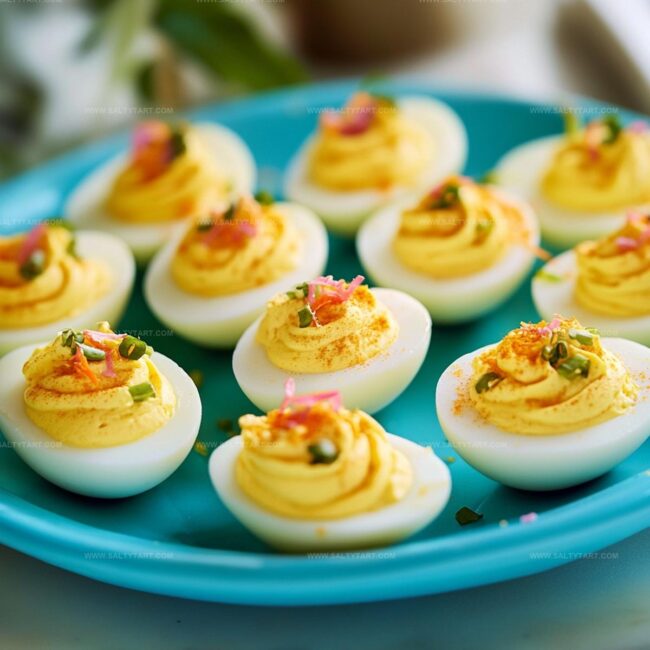The Classic Easter Deviled Eggs Recipe Everyone Will Love
Spring celebrations call for a zesty Easter deviled eggs twist that’ll make everyone smile.
Colorful and playful, these appetizers transform ordinary hard-boiled eggs into festive bites.
My grandmother’s secret technique involves creating smooth, creamy fillings packed with unexpected flavor.
Crisp herbs and tangy mustard add unexpected depth to classic party fare.
Creamy yolks mixed with rich ingredients create irresistible nibbles perfect for brunch or picnics.
Delicate paprika sprinkles and fresh chives make each egg a miniature work of art.
You’ll want to serve these crowd-pleasing morsels that promise to delight even the pickiest guests.
What Makes Easter Deviled Eggs a Classic
Ingredients for Easter Deviled Eggs
Main Ingredients:Seasoning Group:Preparation Group:How to Make Easter Deviled Eggs
Step 1: Boil Eggs Perfectly
Fill a pot with cold water and gently place whole eggs inside. Bring water to a rolling boil over high heat.
Once boiling, cover the pot and remove from heat. Let eggs sit undisturbed for 10-12 minutes to achieve a creamy, tender yolk.
Step 2: Chill and Peel Eggs
Transfer eggs immediately into an ice water bath to stop cooking. This rapid cooling helps prevent gray rings around yolks.
Crack each egg’s shell gently and peel under cool running water, ensuring smooth egg white surfaces.
Step 3: Prepare Yolk Filling
Carefully slice eggs lengthwise using a sharp knife.
Pop out yellow yolks into a mixing bowl. Use a fork to mash yolks into a fine, crumbly texture.
Step 4: Create Creamy Filling
Blend yolks with these ingredients:Whip ingredients until the mixture becomes silky and smooth with no lumps.
Step 5: Assemble Deviled Eggs
Scoop or pipe the yolk mixture back into egg white halves.
Create elegant swirls or peaks using a piping bag for a professional presentation. Dust lightly with paprika for a classic, colorful finish.
Step 6: Serve and Enjoy
Arrange deviled eggs on a decorative platter. Serve chilled as an appetizer or party snack.
These eggs are perfect for Easter, picnics, or family gatherings.
Helpful Tips for Deviled Eggs
Variations for Easter Deviled Eggs
Pairing Suggestions for Easter Deviled Eggs
Crisp white wine like Sauvignon Blanc perfectly complements the creamy, tangy deviled eggs with its bright acidity and clean finish.
Serve alongside charcuterie board featuring prosciutto, mild gouda, and cornichon pickles to create a balanced starter that enhances the egg’s rich texture.
Sprinkle fresh chopped chives or dill on top to add a light, fresh dimension that cuts through the egg’s richness and provides a vibrant color contrast.
Sparkling prosecco works wonderfully, offering effervescence that cleanses the palate between bites of the creamy deviled egg filling.
Proper Storage for Easter Deviled Eggs
FAQs
Cold water helps eggs cook evenly and prevents cracking by gradually heating the eggs from the inside out.
The eggs are done when the yolks are firm and bright yellow with no green ring around the edges, which indicates overcooking.
Peeling eggs under running water or in an ice bath helps the shell separate more easily from the egg white, resulting in smoother, cleaner peeled eggs.
You can prepare the egg whites and yolk mixture separately and store them in the refrigerator, then assemble just before serving to keep the texture fresh and prevent sogginess.
Print
Easter Deviled Eggs Recipe
- Total Time: 26 minutes
- Yield: 6 1x
Description
Springtime celebration comes alive with these delightful Easter Deviled Eggs, boasting creamy, pastel-hued fillings that charm guests with festive flair. Colorful egg whites and rich, tangy centers create a playful appetizer perfect for holiday gatherings.
Ingredients
Main Protein:
- 6 large eggs
Creamy Filling:
- 3 tablespoons mayonnaise
- 1 teaspoon Dijon mustard
Seasoning and Garnish:
- Salt to taste
- Pepper to taste
- Paprika for garnish
Instructions
- Submerge eggs in a pot filled with cold water, ensuring they are completely covered.
- Heat the pot over high flame until water reaches a rolling boil, then immediately cover and remove from heat. Allow eggs to sit undisturbed for 10-11 minutes.
- Transfer eggs into an ice bath, letting them cool rapidly for 2-3 minutes to halt the cooking process.
- Gently crack and peel each egg under cool, running water, removing shells carefully.
- Using a sharp knife, slice eggs precisely in half lengthwise.
- Extract yolks and transfer them into a mixing bowl, leaving pristine egg white halves aside.
- Vigorously blend yolks with mayonnaise, Dijon mustard, salt, and pepper until achieving a creamy, uniform consistency.
- Carefully fill each egg white cavity with the seasoned yolk mixture, either using a spoon or piping technique for elegant presentation.
- Dust the filled eggs with a light sprinkle of paprika for classic garnish and enhanced visual appeal.
- Refrigerate until ready to serve, ensuring maximum freshness and flavor.
Notes
- Ensure eggs are at room temperature to prevent cracking during boiling and promote even cooking.
- Use older eggs for easier peeling, as fresh eggs tend to stick to their shells more stubbornly.
- Gently tap eggs on a hard surface and roll them to create small cracks all over, making shell removal smoother under running water.
- Experiment with alternative seasonings like smoked paprika, chives, or crumbled bacon for unique flavor variations that elevate the classic recipe.
- Prep Time: 15 minutes
- Cook Time: 11 minutes
- Category: Appetizer, Snacks
- Method: Boiling
- Cuisine: American
Nutrition
- Serving Size: 6
- Calories: 125 kcal
- Sugar: 0.3 g
- Sodium: 180 mg
- Fat: 10 g
- Saturated Fat: 1.5 g
- Unsaturated Fat: 7 g
- Trans Fat: 0 g
- Carbohydrates: 1 g
- Fiber: 0 g
- Protein: 6 g
- Cholesterol: 185 mg





Mike Reynolds
Founder & Recipe Developer
Expertise
Farm-to-table cuisine, Seasonal recipe development, Sustainable cooking techniques, Food photography
Education
Asheville-Buncombe Technical Community College (A-B Tech)
Associate Degree in Culinary Arts
Mike studied culinary arts with a strong focus on farm-to-table principles and sustainable cooking. His training emphasized the importance of fresh, local ingredients and environmentally responsible practices in the kitchen.
Mike’s food journey began deep in the Blue Ridge Mountains, where weekends at farmers’ markets and home-cooked meals sparked a lifelong obsession with simple, seasonal eating.
After earning his Associate Degree in Culinary Arts from Asheville-Buncombe Technical Community College, he set out to bring farm-to-table cooking into everyday kitchens, without the fuss.
Mike’s philosophy is all about keeping it fresh, unfussy, and full of heart. When he’s not crafting new single-serving recipes, he’s hiking mountain trails, chatting with local farmers, or experimenting with wild ingredients in his backyard kitchen.